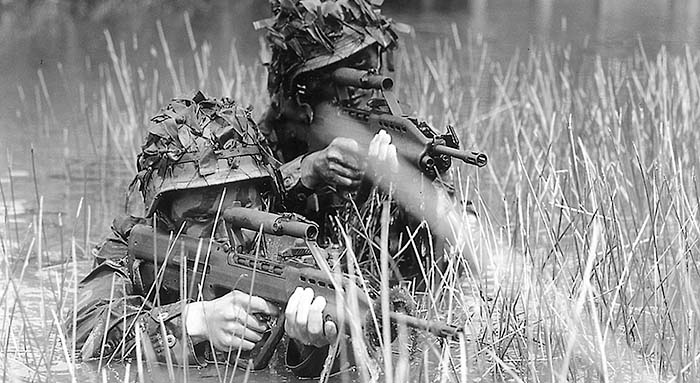By Charles Q. Cutshaw
Singapore has for many years equipped its military forces with M16A1 rifles manufactured under license by Chartered Industries of Singapore, now reorganized and renamed Singapore Technologies Kinetics (STKinetics) in keeping with the new directions undertaken by the company. The M16A1 was a satisfactory infantry rifle for many years, but licensing prohibitions limited Singapore’s ability to market the rifle overseas and also restricted the types of rifles that could be produced. These restraints led to the introduction and production of indigenous designs such as the SAR-80 and SR-88. The SAR-80 and the SR-88 saw only limited service with Singapore’s military, as both were intended primarily for export. In the 1990’s the Singapore military was faced with a dilemma. The M16A1 rifles that formed the backbone of Singapore’s military would reach the end of their effective service life at about the turn of the century. The choice was to either upgrade the M16A1 or produce a new rifle. Singapore opted for the latter choice, but rather than produce a foreign design under license or use a foreign weapon designer as was done with weapons such as the SAR-80 and Ultimax 100 light machine gun, STKinetics’ management decided to develop a new rifle that would be an indigenous project from start to finish. This new rifle was intended to fully meet Singapore’s 21st Century military requirements and at the same time be viable in the highly competitive international small arms export market. The result of STKinetics’ efforts is the SAR-21 assault rifle, now replacing Singapore’s M16A1 rifles in the island-state’s military forces.
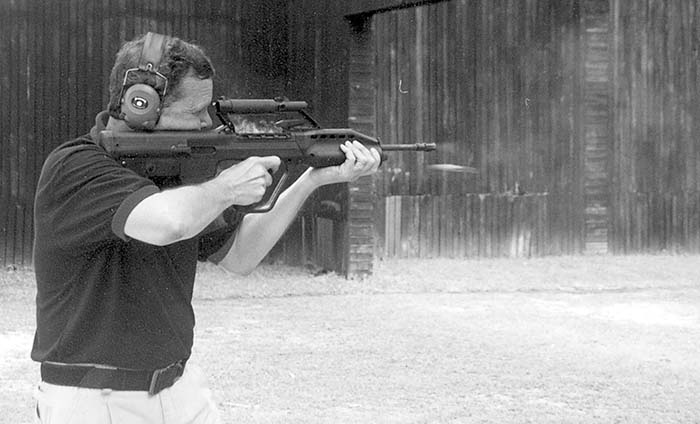
Although the SAR-21 bears superficial resemblance to other bullpup assault rifles, such as the Steyr AUG and IMI Tavor, it is a unique design that is similar to its cousins only in the fact that is of bullpup configuration. There has been a plethora of bullpup rifle designs in recent years, beginning with the Steyr AUG and continuing with weapons such as the British L80, the French FAMAS, the Chinese Type 95/97, the Israeli Tavor and the South African CR-21, not to mention the USA’s questionable Objective Individual Combat Weapon (OICW). The latter is actually a bullpup semiautomatic grenade launcher with a rifle as secondary weapon. Bullpup rifles have the advantage of minimizing a rifle’s overall length by moving the receiver to the rear and integrating it and the buttstock into a single unit. This allows the use of a full-length barrel in a rifle with the overall external dimensions of a short-barreled carbine. The bullpup configuration is especially advantageous in close combat situations or when soldiers are mounted in vehicles where the design allows for convenient ingress/egress from vehicles and more effective tactical operations in close spaces. The disadvantages of the bullpup design include the fact that the receiver is next to the shooter’s face, which causes discomfort to some that are concerned about their well being in the event of a ruptured cartridge or magazine explosion. Also, since the trigger is perforce well forward of the firing mechanism, any bullpup design must incorporate a long and sometimes cumbersome linkage between the trigger and the rear-mounted fire control unit. The bullpup configuration places more demands on small arms design engineers than conventional rifles and it logically follows that some bullpup designs are better than others. Moreover, the untraditional appearance of bullpup rifles gives many shooters an almost “knee-jerk” adversity to them. Regardless, military rifle designers have introduced far more bullpup designs in recent years than conventional types, indicating a trend towards bullpup configuration. The sole exceptions to the bullpup rule are the conventionally configured Russian AN-94 and German G36.
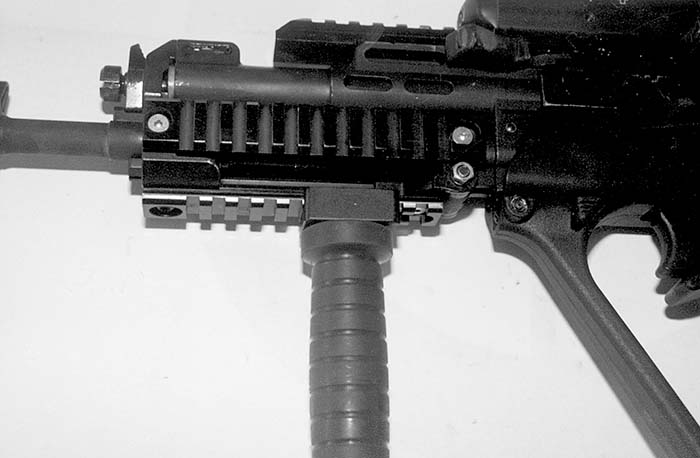
Overall, we consider the SAR-21 to be an excellent basic design. The rifle is manufactured using the most modern materials and in state of the art manufacturing facilities. During our visit to STKinetics in preparation for this article, the author noted that the SAR-21 production machinery was almost fully computer numerically controlled, which enhances overall quality. The receiver halves are electronically vibration welded together resulting in an exceptionally strong and virtually seamless surface. Although the SAR-21 receiver halves are polymer, they are reinforced with steel at critical stress points. SAR-21 barrels are cold hammer forged. Magazines are polymer, translucent and are indexed so the shooter can readily observe how many rounds he has remaining. Controls of the SAR-21 are fully ambidextrous, although no provision is made for left-hand ejection of spent cases. In testing prior to adoption by Singapore’s military, the rifles were repeatedly dropped onto concrete surfaces from one-meter heights without effect. The optical sight and laser aimer retained their zeros and the rifle functioned flawlessly. As mentioned, many shooters are wary of bullpup rifles because the receiver and chamber are placed close to the cheekbone, but the SAR-21 has a patented safety system to prevent injuries in the unlikely event of a burst barrel or chamber explosion. The first component of the safety system is a molded-in composite plate directly beneath the cheek rest that protects the shooter’s face. The second element of the SAR-21 safety system is a vent in the barrel extension to direct any high-pressure gases that might escape in the event of a ruptured primer or cartridge case away from the shooter’s face. This system should eliminate any concerns regarding the SAR-21s safety. The trigger mechanism of the SAR-21 is excellent with relatively light and crisp release that we estimate to be approximately five pounds. There is little creep or backlash. This is accomplished via a stiff sliding plate that links the trigger and fire control unit, rather than a flexible rod or similar mechanism used in some other bullpup designs that results in a heavy and sluggish trigger pull.
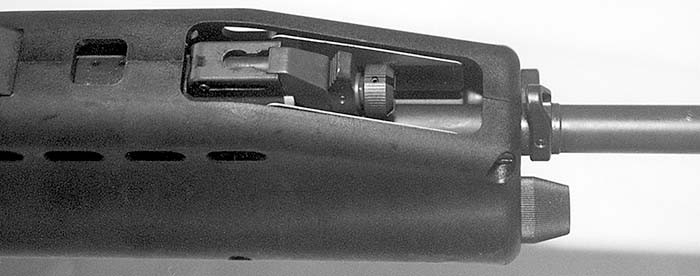
The SAR-21 uses what might best be described as a modified Kalashnikov/Stoner operating system, with a long Kalashnikov-style operating rod in a gas tube over the barrel and a Stoner-style unitary bolt carrier with firing pin – retained cam pin and bolt. This melding of two proven operating systems should be extremely reliable and robust. The gas port settings are adjustable without tools to compensate for heavy use. Adjustment is accomplished by simply lifting the gas regulator and rotating the adjustment knob to one of its three settings. The bolt itself is of the conventional rotating type, its two massive lugs locking into recesses in the barrel extension. The polymer receiver thus receives little stress. The rifle is select fire, with the selector positioned in the detachable fire control unit near the shooter’s shoulder. We will comment further on this feature below. The safety is a simple push-push device just forward of the trigger where it can easily be operated by the shooter’s trigger finger. The SAR-21 charging handle is fully ambidextrous and easily reached with either hand.
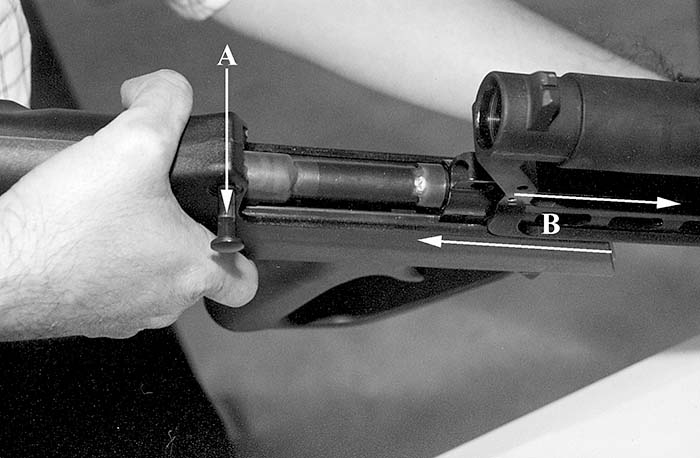
Field stripping the SAR-21 is intuitive and can easily be accomplished without the use of any tools. The upper and lower receivers separate by pressing two retaining pins, which are prevented from dropping away by spring loaded ball and socket mechanisms. Once the upper and lower receivers are separated, the operating rod and bolt group can be withdrawn from the upper receiver. A small lever at the rear of the bolt carrier retains the firing pin, which upon withdrawal releases the bolt cam pin. Once the cam pin is removed, the bolt can be withdrawn from the carrier. For routine maintenance, no further disassembly is required. If the soldier desires to remove the fire control unit, this can be accomplished by removing a third retaining pin just forward of the buttplate. The fire control unit can then be withdrawn by pulling it downward. With no practice whatsoever, the author was able to fully disassemble the SAR-21 in approximately 20 seconds. Singapore soldiers who are thoroughly familiar with the rifle can disassemble and reassemble it in less than the time that we took to disassemble it
Although the data for the rifle state that it is equipped with a 1.5x optical sight with open sight backup, the statistics do not do justice to the outstanding optical sights of the SAR-21. Most notably, the rifle does not require zeroing! While this may be heresy to “old soldiers” such as the author, we were given a rifle straight from production line, handed several magazines of ammunition and offered the opportunity to engage a series of standard silhouettes of varying sizes at 300 meters. We loaded the rifle, placed the sight reticle on the first target and to our astonishment dropped the target with the first round! We then proceeded to rapidly engage the entire series of silhouettes of varying sizes at the 300-meter line as quickly as we could fire, switch targets and fire again. We achieved over 90 per cent hits scored using extremely rapid semiautomatic fire – without zeroing the rifle! As a former infantry officer who has engaged in training soldiers to zero and effectively use their rifles, the author is impressed with the fact that the SAR-21 dispense with the lengthy zeroing process. This feature will save untold training hours because the soldier can take his rifle directly to the range to learn how to effectively use it. Since Singapore has universal national service of 2 1/2 years for all males beginning at 18 years of age, with up to 40 days’ mandatory military training annually throughout their adult lives, the benefit of each soldier being issued a rifle that requires no zeroing is obvious. The reticle of the SAR-21 sight is such that it also leads the shooter’s eye naturally to the target, another advantage which will certainly inspire soldier confidence in the rifle because it enables him to quickly acquire and hit targets to the limits the rifle’s effective range. We were impressed not only with the simplicity of the sighting system, but with our ability to achieve a high percentage of rapid-fire hits at 300 meters without any zeroing whatsoever. After beginning the day’s firing at the 300 meter line, we moved up to 200 and then to 100 meters, where we were able to engage targets with even greater speed and accuracy. The SAR-21 is also equipped with an integral laser-aiming device for use in low light conditions. The laser operates not only in the visible spectrum, but can be changed to operate in the infrared (IR) range, as well. The activating switch for the laser is on the rifle’s forearm just beneath the shooter’s thumb. Like the optical sight, the laser is pre-zeroed before the rifle leaves the factory. The laser-aiming device is powered by a single “AA” battery, commonly available worldwide.
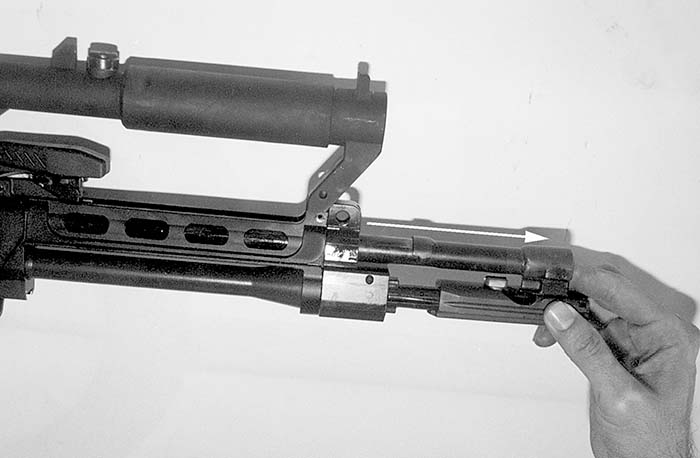
Throughout the morning’s shooting, the functioning of the SAR-21 was flawless. There was not one stoppage of any sort, regardless of whether we fired semi or fully automatic. The rifle is extremely controllable under rapid-fire semiautomatic or when firing in full automatic. This is attributable to its “straight line” design which keep recoil forces in direct line with the shooter’s shoulder. The rifle also has a natural balance that places the center of gravity just over the shooter’s hand so that the rifle can easily be pointed and even fired one-handed if desired. Felt recoil is extremely light. The SAR-21 is among the best handling and easiest rifles to use that the author has ever experienced.
Several variants of the SAR-21 will be offered for export:
* SAR-21 Light Machine Gun. The SAR-21 LMG differs from the basic rifle in that it fires from the open bolt and is equipped with a heavy barrel and integral folding bipod.
* SAR-21/40mm Grenade Launcher. The basic SAR-21 equipped with a short barreled 40x46mm grenade launcher. The laser-aiming device is mounted on the launcher mounting quadrant to facilitate quick and accurate target acquisition.
* SAR-21 P-Rail. This variant of the SAR-21 is fitted with a MIL-STD-1913 rail array in place of the forearm and integrated optical sight.
* SAR-21 Sharp Shooter. This is a variant of the SAR-21 intended for designated marksmen who require increased accuracy and the ability to engage point targets more reliably. The 1.5x integrated optical sight is replaced with a 3x sight in this variant.
It should be noted that given the standard variants of the SAR-21 listed above, others come to mind for use by military organizations with specialized requirements. For example, a heavy barreled rifle could be manufactured using the barrel and bipod of the LMG version and the 3x sight from the Sharp Shooter variant. Rifles could easily be made with different barrel lengths for specialized users. By purchasing different sub-assemblies, using units could easily reconfigure their SAR-21s into any one of several variants. The flexibility of the SAR-21 in this regard is one of its strong points.
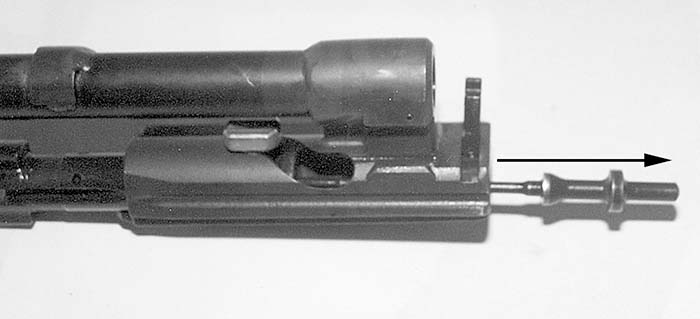
Based upon our brief testing, we found the SAR-21 to give every indication of having the potential to be one of the world’s best combat rifles. Although STKinetics makes a point of noting that the rifle and its controls are sized for Asian men whose bodies are typically smaller than their Western counterparts, we found the rifle to be extremely comfortable to shoot and the author is definitely NOT a small man (6’2” tall, 190lb)! The sole feature of the SAR-21 that we found to be objectionable was the positioning of the selector switch between the magazine and buttplate, although STKinetics engineers stated that Singapore’s military had no problem with its positioning. Despite this, in order to change from one fire mode to another, the SAR-21 shooter must completely remove one hand from the rifle and grope for the selector button, which is pressed from one side of the buttstock to the other to select full or semiautomatic fire. We believe the ability to select between full and semiautomatic fire in combat situations must be virtually instantaneous without repositioning either hand and that STKinetics should move the selector switch forward to a location near the trigger guard for export versions of the SAR-21. Otherwise, the ergonomics of the SAR-21 are superb. The competition in world small arms markets is presently intense and the SAR-21 joins the ranks of several new weapons competing for essentially limited markets. With the exception of the Heckler & Koch G36 and Izhmash’s AN-94, all recently introduced combat rifle designs have been bullpups. We have not had the opportunity to examine all of the SAR-21’s bullpup rivals, but we believe that the SAR-21 will be highly competitive in the world small arms market.
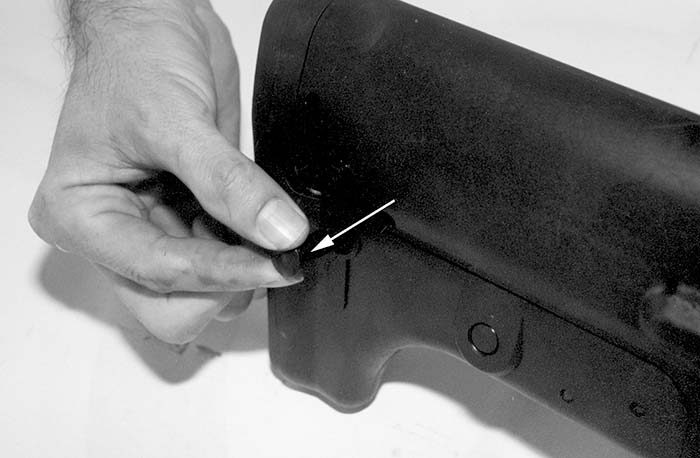
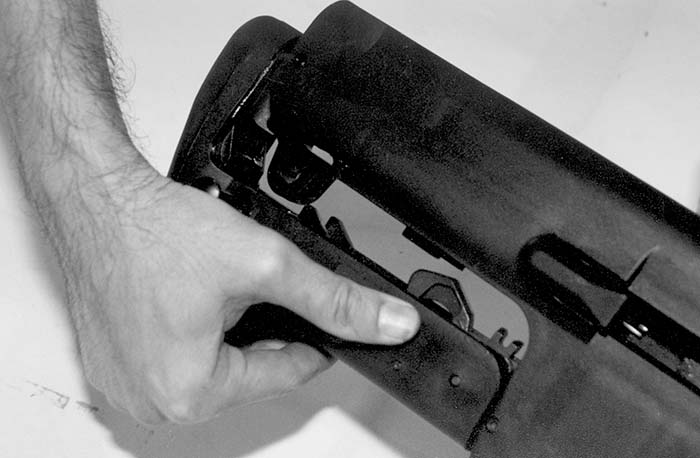
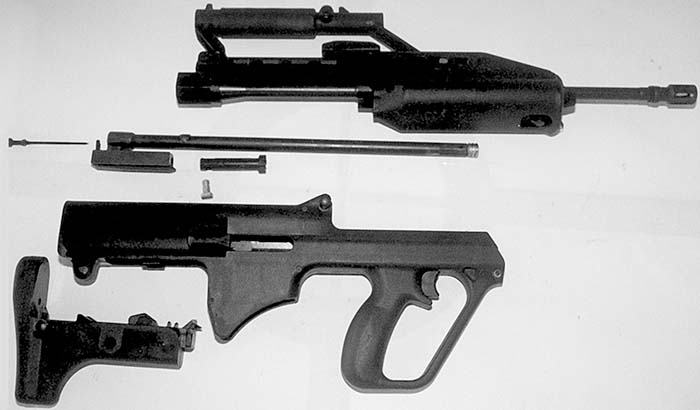
| This article first appeared in Small Arms Review V3N10 (July 2000) |



